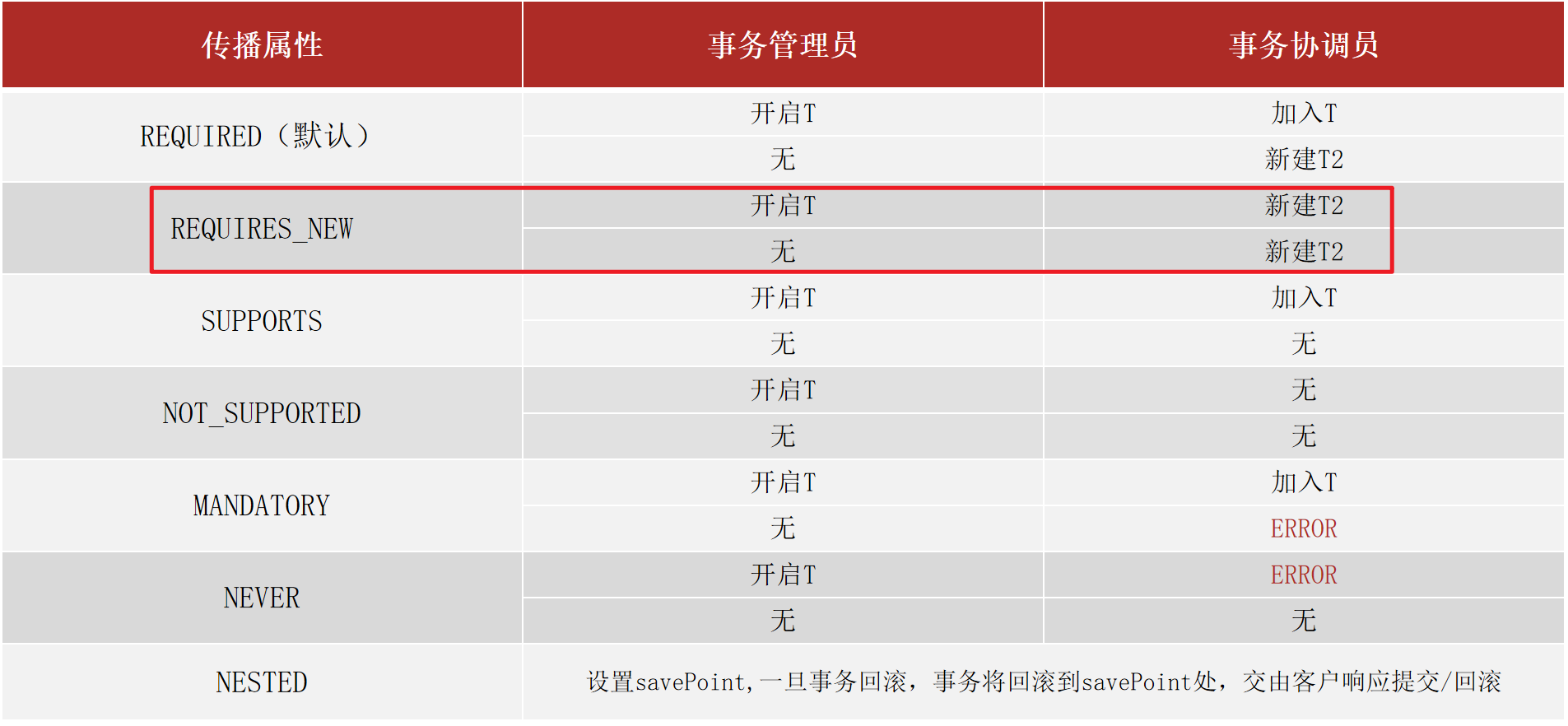Spring-声明式事务
一、回顾事务
- 事务在项目开发过程非常重要,涉及到数据的一致性的问题,不容马虎!
- 事务管理是企业级应用程序开发中必备技术,用来确保数据的完整性和一致性。
事务的四个属性 ACID
原子性(atomicity)
事务是原子性操作,由一系列动作组成,事务的原子性确保动作要么全部完成,要么完全不起作用
一致性(consistency)
一旦所有事务动作完成,事务就要被提交。数据和资源处于一种满足业务规则的一致性状态中
隔离性(isolation)
可能多个事务会同时处理相同的数据,因此每个事务都应该与其他事务隔离开来,防止数据损坏
持久性(durability)
事务一旦完成,无论系统发生什么错误,结果都不会受到影响。通常情况下,事务的结果被写到持久化存储器中
二、测试
将上面的代码拷贝到一个新项目中
在之前的案例中,我们给userDao接口新增两个方法,删除和增加用户;
//添加一个用户
int addUser(User user);
//根据id删除用户
int deleteUser(int id);mapper文件,我们故意把 delete 写错成 deletes,测试!
<insert id="addUser" parameterType="com.kuang.pojo.User">
insert into user (id,name,pwd) values (#{id},#{name},#{pwd})
</insert>
<delete id="deleteUser" parameterType="int">
deletes from user where id = #{id}
</delete>编写接口的实现类,在实现类中,我们去操作一波
public class UserDaoImpl extends SqlSessionDaoSupport implements UserMapper {
//增加一些操作
public List<User> selectUser() {
User user = new User(4,"小明","123456");
UserMapper mapper = getSqlSession().getMapper(UserMapper.class);
mapper.addUser(user);
mapper.deleteUser(4);
return mapper.selectUser();
}
//新增
public int addUser(User user) {
UserMapper mapper = getSqlSession().getMapper(UserMapper.class);
return mapper.addUser(user);
}
//删除
public int deleteUser(int id) {
UserMapper mapper = getSqlSession().getMapper(UserMapper.class);
return mapper.deleteUser(id);
}
}测试:
@Test
public void test2(){
ApplicationContext context = new ClassPathXmlApplicationContext("beans.xml");
UserMapper mapper = (UserMapper) context.getBean("userDao");
List<User> user = mapper.selectUser();
System.out.println(user);
}报错:sql 异常,delete 写错了
结果 :插入成功!
没有进行事务的管理;我们想让他们都成功才算成功,有一个失败,就都算失败,我们就应该需要 事务!
以前我们都需要自己手动管理事务,十分麻烦!
但是 Spring 给我们提供了事务管理,我们只需要配置即可;
三、Spring 中的事务管理
Spring 在不同的事务管理 API 之上定义了一个抽象层,使得开发人员不必了解底层的事务管理 API 就可以使用 Spring 的事务管理机制。Spring 支持编程式事务管理和声明式的事务管理。
1、编程式事务管理
- 将事务管理代码嵌到业务方法中来控制事务的提交和回滚
- 缺点:必须在每个事务操作业务逻辑中包含额外的事务管理代码
2、声明式事务管理
- 一般情况下比编程式事务好用。
- 将事务管理代码从业务方法中分离出来,以声明的方式来实现事务管理。
- 将事务管理作为横切关注点,通过 aop 方法模块化。Spring 中通过 Spring AOP 框架支持声明式事务管理。
3、使用 Spring 管理事务,注意头文件的约束导入 : tx
xmlns:tx="http://www.springframework.org/schema/tx"
http://www.springframework.org/schema/tx
http://www.springframework.org/schema/tx/spring-tx.xsd">4、事务管理器
- 无论使用 Spring 的哪种事务管理策略(编程式或者声明式)事务管理器都是必须的。
- 事务管理器 就是 Spring 的核心事务管理抽象,管理封装了一组独立于技术的方法。
5、JDBC 事务
<bean id="transactionManager" class="org.springframework.jdbc.datasource.DataSourceTransactionManager">
<property name="dataSource" ref="dataSource" />
</bean>6、配置好事务管理器后我们需要去配置事务的通知
<!--配置事务通知-->
<tx:advice id="txAdvice" transaction-manager="transactionManager">
<tx:attributes>
<!--配置哪些方法使用什么样的事务,配置事务的传播特性-->
<tx:method name="add" propagation="REQUIRED"/>
<tx:method name="delete" propagation="REQUIRED"/>
<tx:method name="update" propagation="REQUIRED"/>
<tx:method name="search*" propagation="REQUIRED"/>
<tx:method name="get" read-only="true"/>
<tx:method name="*" propagation="REQUIRED"/>
</tx:attributes>
</tx:advice>7、spring 事务传播特性
事务传播行为就是多个事务方法相互调用时,事务如何在这些方法间传播。spring 支持 7 种事务传播行为:
- propagation_requierd:如果当前没有事务,就新建一个事务,如果已存在一个事务中,加入到这个事务中,这是最常见的选择。
- propagation_supports:支持当前事务,如果没有当前事务,就以非事务方法执行。
- propagation_mandatory:使用当前事务,如果没有当前事务,就抛出异常。
- propagation_required_new:新建事务,如果当前存在事务,把当前事务挂起。
- propagation_not_supported:以非事务方式执行操作,如果当前存在事务,就把当前事务挂起。
- propagation_never:以非事务方式执行操作,如果当前事务存在则抛出异常。
- propagation_nested:如果当前存在事务,则在嵌套事务内执行。如果当前没有事务,则执行与propagation_required类似的操作
Spring 默认的事务传播行为是 PROPAGATION_REQUIRED,它适合于绝大多数的情况。
假设 ServiveX#methodX() 都工作在事务环境下(即都被 Spring 事务增强了),假设程序中存在如下的调用链:Service1#method1()->Service2#method2()->Service3#method3(),那么这 3 个服务类的 3 个方法通过 Spring 的事务传播机制都工作在同一个事务中。
就好比,我们刚才的几个方法存在调用,所以会被放在一组事务当中!
8、配置 AOP
导入aop的头文件!
<!--配置aop织入事务-->
<aop:config>
<aop:pointcut id="txPointcut" expression="execution(* com.kuang.dao.*.*(..))"/>
<aop:advisor advice-ref="txAdvice" pointcut-ref="txPointcut"/>
</aop:config>9、进行测试
删掉刚才插入的数据,再次测试!
@Test
public void test2(){
ApplicationContext context = new ClassPathXmlApplicationContext("beans.xml");
UserMapper mapper = (UserMapper) context.getBean("userDao");
List<User> user = mapper.selectUser();
System.out.println(user);
}五、Spring 的事务角色
- 事务管理员:发起事务方,在 Spring 中通常指代业务层开启事务的方法
- 事务协调员:加入事务方,在 Spring 中通常指代数据层方法,也可以是业务层方法
六、Spring 事务相关配置
什么样的异常,Spring 事务默认是不进行回滚的?
1. 事务配置
| 属性 | 作用 | 示例 |
|---|---|---|
| read0nly | 设置是否为只读事务 | read0nly=true(只读事务) |
| timeout | 设置事务超时时间 | timeout = -1(永不超时) |
| rollbackFor | 设置事务回滚异常(Class) | rollbackFor= |
| rollbackForClassName | 设置事务回滚异常(String) | 同上格式为字符串 |
| noRollbackFor | 设置事务不回滚异常(Class) | noRollbackFor= |
| noRollbackForClassName | 设置事务不回滚异常(String) | 同上格式为字符串 |
| isolation | 设置事务隔离级别 | isolation = Isolation.DEFAULT |
| propagation | 设置事务传播行为 | …… |
注意:
- 对于 RuntimeException 类型异常或者 Error 错误,Spring 事务能够进行回滚操作。
- 但是对于编译器异常,Spring 事务是不进行回滚的,所以需要使用 rollbackFor 来设置要回滚的异常。
2. 事务传播行为
事务传播行为:事务协调员对事物管理员所携带的事物的处理态度。


